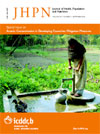
|
The Journal of Health, Population and Nutrition
icddr,b
ISSN: 1606-0997
EISSN: 1606-0997
Vol. 27, No. 2, 2009, pp. 108-123
|
 Bioline Code: hn09014
Bioline Code: hn09014
Full paper language: English
Document type: Research Article
Document available free of charge
|
|
|
The Journal of Health, Population and Nutrition, Vol. 27, No. 2, 2009, pp. 108-123
| en |
Causes of Maternal Mortality Decline in Matlab, Bangladesh
Chowdhury, Mahbub Elahi; Ahmed, Anisuddin; Kalim, Nahid & Koblinsky, Marge
Abstract
Bangladesh is distinct among developing countries in achieving a low maternal mortality ratio (MMR) of 322 per 100,000 livebirths despite the very low use of skilled care at delivery (13% nationally). This variation has also been observed in Matlab, a rural area in Bangladesh, where longitudinal data on maternal mortality are available since the mid-1970s. The current study investigated the possible causes of the maternal mortality decline in Matlab. The study analyzed 769 maternal deaths and 215,779 pregnancy records from the Health and Demographic Surveillance System (HDSS) and other sources of safe motherhood data in the ICDDR,B and government service areas in Matlab during 1976-2005. The major interventions that took place in both the areas since the early 1980s were the family-planning programme plus safe menstrual regulation services and safe motherhood interventions (midwives for normal delivery in the ICDDR,B service area from the late 1980s and equal access to comprehensive emergency obstetric care [EmOC] in public facilities for women from both the areas). National programmes for social development and empowerment of women through education and microcredit programmes were implemented in both the areas. The quantitative findings were supplemented by a qualitative study by interviewing local community care providers for their change in practices for maternal healthcare over time. After the introduction of the safe motherhood programme, reduction in maternal mortality was higher in the ICDDR,B service area (68.6%) than in the government service area (50.4%) during 1986-1989 and 2001-2005. Reduction in the number of maternal deaths due to the fertility decline was higher in the government service area (30%) than in the ICDDR,B service area (23%) during 1979-2005. In each area, there has been substantial reduction in abortion-related mortali-
ty-86.7% and 78.3%-in the ICDDR,B and government service areas respectively. Education of women was a strong predictor of the maternal mortality decline in both the areas. Possible explanations for the maternal mortality decline in Matlab are: better access to comprehensive EmOC services, reduction in the total fertility rate, and improved education of women. To achieve the Millenium Development Goal 5 targets,
policies that bring further improved comprehensive EmOC, strengthened family-planning services, and expanded education of females are essential.
Keywords
Causes of death; Delivery; Health services; Health facilities; Healthcare; Maternal health; Maternal mortality; Obstetric care; Risk factors; Bangladesh
|
| |
© Copyright 2009 - International Centre For Diarrhoeal Disease Research, Bangladesh
Alternative site location: http://www.jhpn.net
|
|
